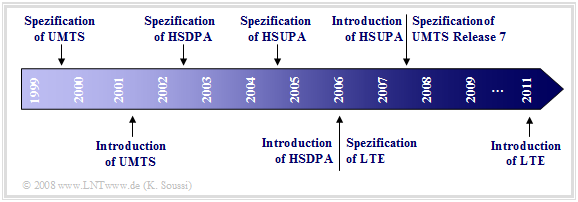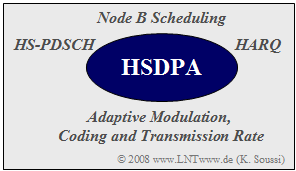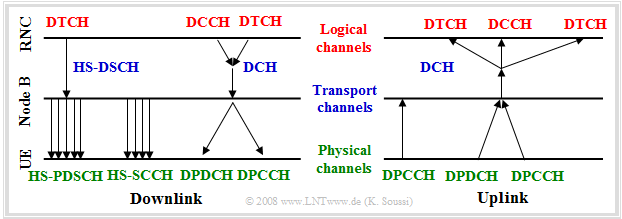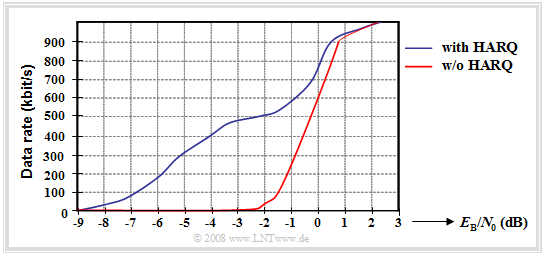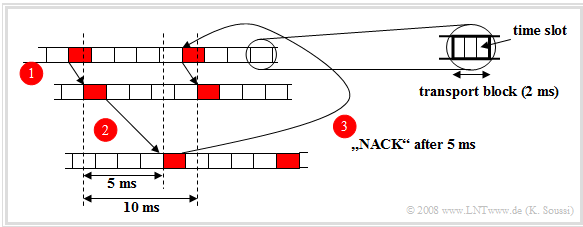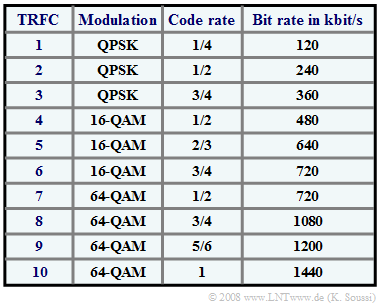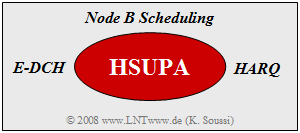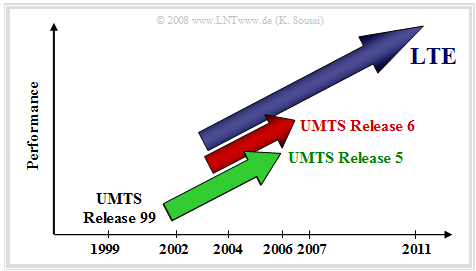Contents
High–Speed Downlink Packet Access
In order to meet the increasing demand for higher data rates in mobile communications and to ensure ever better quality of service, the UMTS Release 99 standard has been further developed in five phases up to the present day (2008). The diagram shows the individual development phases in chronological order.
The most important further developments were
- the UMTS Release 5 with HSDPA and
- the UMTS Release 6 with HSUPA.
For these two standards, the main focus was on increasing the data rates provided for downlink and uplink as well as greater bandwidth efficiency and cell capacity. Together, HSDPA and HSUPA make up the HSPA standard.
- In 2002, High-Speed Downlink Packet Access - abbreviated HSDPA - was specified with UMTS Release 5 and introduced in 2006 to increase data rate and throughput compared to the original UMTS standard as well as to reduce response times for packet-switched transmission.
- In HSPDA, the data rates provided are between $\text{500 kbit/s}$ and $\text{3.6 Mbit/s}$ - theoretically even up to $\text{14.4 Mbit/s}$. Compared to the data rate of UMTS R'99 $\text{(14.4 kbit/s}$ to $\text{2 Mbit/s)}$ these values represent a doubling to quadrupling.
The following technical procedures contribute to the increase in performance of HSDPA compared to UMTS. The diagram compiles these features:
- Introduction of an additional shared channel: HS-PDSCH,
- Use of the Hybrid ARQ method,
- minimization of delay times,
- introduction of Node B scheduling,
- Use of adaptive Modulation, coding and transmission rate.
Additional channels in HSDPA
The High-Speed Downlink Physical High Speed Channel - abbreviated HS-PDCH - is a high-speed transport channel used for the transmission of subscriber data. It combines the characteristics of a shared and a dedicated channel:
- In the downlink, one or more channels can be used by multiple subscribers simultaneously. This allows simultaneous transmission of the same data to different subscribers as well as a significant increase in transmission speed by bundling several channels of this type.
- In any HS-PDCH, the spreading factor $J = 16$. This means that theoretically up to fifteen such channels can be used simultaneously in one cell. In practice, however, only between five and ten channels are ever used, since the remaining channels are required for the operation of other services.
Resource allocation for the High-Speed Shared Data Channel (HS-DSCH) is done via so-called High-Speed Shared Control Channels (HS-SCCH). A receiver must therefore be able to receive and decode up to four such channels simultaneously.
- In addition to the channels presented above, a Dedicated Physical Control Channel (DPCCH) is used for the transmission of control data in the uplink and a Dedicated Control Channel (DCCH) for the localization procedure in the downlink and uplink.
- A Dedicated Traffic Channel (DTCH) is responsible for the transmission of IP payload data in the uplink direction respectively.
HARQ procedure and "Node B Scheduling"
Another feature of HSDPA is the reduction of packet round-trip delay (RTD) and the use of HARQ:
- The round-trip delay has been reduced by HSDPA to $\text{70 ms}$ (compared $\text{160 ... 200 ms}$ with UMTS R'99), which is of great importance for some applications (for example web browsing) . This reduction was achieved by decreasing the transport block length to about $2$ milliseconds (previously this $\text{10 ms}$ and $\text{20 ms}$ respectively).
- In each "Node B", a Hybrid Automatic Repeat Request (HARQ) has been implemented to minimize transmission delays. This mechanism prevents significant delays from occurring due to retransmission of erroneous blocks. This is because such delays can be interpreted by the TCP protocol as blocking, which then leads to further delays.
Using the HARQ mechanism and with transport block lengths of $\text{2 ms}$ the transmission delays in HSPDA are less than $\text{10 ms}$. This is a crucial improvement over UMTS, where error detection (associated with retransmission) takes approximately $\text{90 ms}$ .
In the HARQ procedure, the detection of an error or no error is acknowledged for each individual transport frame. This procedure is referred to as Stop and Wait (SAW).
$\text{Example 1:}$ The graph shows the achievable data rate as a function of the quotient $E_{\rm B}/N_0$ (in dB).
- You can see decisive improvements by the HARQ mechanism, especially for small values of $E_{\rm B}/N_0$.
- In contrast, HARQ does not further increase the data rate if $10 - \lg \E_{\rm B}/N_0 > 2 \ \rm dB$ .
The following graphic is intended to illustrate how the HARQ process works. The following steps are to be distinguished:
- Before transmission, the base station informs the receiver of an upcoming transmission using the HS-SCCH channel, where a HS-SCCH frame has three time slots.
- Control data arrives at the receiver and is evaluated immediately after the arrival of the first SCCH time slot.
- Data transmission on the HS-PDSCH starts as soon as the subscriber has received the first two time slots of the control data block.
- Within $\text{5 ms}$ of receiving a frame of data, the receiver must have decoded the entire frame and checked for errors.
- If the transmission is error free, a positive acknowledgement (ACK) is sent upstream, otherwise a Non Acknowledgement (NACK) is sent.
Since the HARQ does not send a new frame until the acknowledgement of the already transmitted frames is received, the receiver must be able to manage up to eight HARQs. This guarantees the correct sequence and thereby the correct processing of the data in the higher levels.
$\text{It is also worth mentioning:}$
In addition to HARQ, in the UMTS Release 5 a Node B Scheduling was introduced to be able to react quickly to changes in the transmission conditions of individual nodes (for example, due to fading).
- This scheduling is used to decide which frames are assigned to which transmission channel.
- Priorities are assigned during scheduling. A frame is only sent when it has the highest priority, which means that it is most likely to be received correctly.
- This scheduling makes better use of the available bandwidth and significantly increases cell capacity.
Adaptive modulation, adaptive coding and adaptive transmission rate
In HSDPA, the signals are adaptively modulated. This means:
- Under good transmission conditions, higher-level modulation (16-QAM or 64-QAM) is used.
- In poorer conditions, it is switched to Quaternary Phase Shift Keying (QPSK) or 4-QAM.
In addition to modulation, the coding as well as the number of HS-DSCH channels used simultaneously by a subscriber can be flexibly and quickly $($all $\text{2 ms)}$ changed depending on the channel quality. Despite the simultaneous use of adaptive modulation and adaptive coding, the power is always kept constant.
Power control runs differently in HSDPA than in UMTS R'99:
- The transmit power is always adapted to the signal quality, while the bandwidth should be kept as constant as possible.
- Only if the power can no longer be increased, the spreading factor is increased and thus the data rate is lowered.
The maximum achievable data rate depends mainly on the receiver performance and on the transport format and resource combinations (TFRC).
In the table, various parameter combinations for modulation and code rate are given and the resulting bit rates can be seen. Not considered here is the overhead.
High–Speed Uplink Packet Access
Since UMTS R'99, the specifications for the uplink have not been further developed, although bidirectional symmetrical applications have become increasingly important and ever greater demands have been placed on transmission speeds. Until the introduction of Release 6, data rates were between $\text{64 kbit/s}$ and $\text{128 kbit/s}$, and up to $\text{384 kbit/s}$ under ideal conditions.
With UMTS Release 6, High-Speed Uplink Packet Access (HSUPA) was defined in 2004 and introduced in 2007. This significantly increased the data rates on the uplink. These are theoretically up to $\text{5.8 Mbit/s}$. In practice - taking into account simultaneous transmission for multiple users and receiver capacity - transmission rates of up to approx. $\text{800 kbit/s}$ are still achieved.
The essential improvement by HSUPA is due to the introduction of an additional uplink channel, the Enhanced Dedicated Channel (E-DCH). This minimizes, among other things in the dedicated uplink channels, the impact of applications with highly varying and sometimes very intensive data volumes (English: Bursty Traffic).
However, although the E-DCH is a dedicated transport channel, it does not guarantee the subscriber a fixed bandwidth in the uplink direction, as is the case with UMTS R'99. This flexible and efficient allocation of bandwidth depending on channel conditions allows a substantial increase in cell capacity.
In addition to the new transport channel (E-DCH) the following procedures were also introduced in the uplink (HSUPA) analogous to the downlink (HSDPA) in addition:
- Node B Scheduling,
- Hybrid Automatic Repeat Request (HARQ).
The use of HSUPA in the uplink only makes sense if it is combined with HSDPA in the downlink. Their interaction significantly increases the performance of the overall system.
UTRAN Long Term Evolution
Long Term Evolution $\rm (LTE)$ stellt ein Mobilfunksystem der vierten Generation dar, das von der 3gpp parallel zu den unterschiedlichen Weiterentwicklungsphasen von UMTS entworfen und standardisiert wurde, um den stetig wachsenden Anforderungen an zukünftige Mobilfunksysteme gerecht zu werden. Dieses System wird auch als High Speed OFDM Packet Access $\rm (HSOPA)$ bezeichnet.
Das Schaubild fasst die Entwicklung der Mobilfunksysteme aus der Sicht des Jahres 2011 zusammen.
LTE wurde als zukunftsweisende Alternative zu den Mobilfunksystemen der dritten Generation rntwickelt. Die Grundzüge von LTE wurden 2004 definiert, konkrete Anforderungen wurden aber erst 2006 erstellt. Erste Systeme begannen 2011 mit dem Betrieb.
Nachfolgend sind einige Merkmale von UTRAN–LTE stichpunktartig und kommentarlos aufgelistet:
- Die für GSM und UMTS zugewiesenen Frequenzbereiche werden weiterhin verwendet. Es ist eine Erweiterung in den Bereich um $\text{2600 MHz}$ geplant.
- Es können zwischen $200$ und $400$ aktive Teilnehmer gleichzeitig versorgt werden, was eine Steigerung der Zellenkapazität gegenüber UMTS um den Faktor $2$ bis $3$ bedeutet.
- Die Reichweite beträgt $\text{5 km}$ (bei optimaler Güte) bis zu $\text{100 km}$ (mit reduzierter Qualität). Die maximalen Datenraten werden mit $\text{100 Mbit/s}$ im Downlink und $\text{50 Mbit/s}$ im Uplink angegeben.
- Die Verzögerungszeiten werden auf weniger als $\text{5 ms}$ bei größeren Bandbreitenzuweisungen und auf $\text{10 ms}$ bei kleineren Bandbreitenzuweisungen herabgesetzt.
- Die Bandbreiten können mit $\text{1.25 MHz}$, $\text{2.5 MHz}$, $\text{5 MHz}$, $\text{10 MHz}$, $\text{15 MHz}$ und $\text{20 MHz}$ in einem sehr weiten Bereich flexibel zugewiesen werden .
- Die verwendeten Vielfachzugriffsverfahren sind Orthogonal Frequency Division Multiple Access (OFDMA) im Downlink und Single Carrier Frequency Division Multiple Multiplexing (SC–FDMA) im Uplink.
- Trotz dieser vielfachen Neuerungen gibt es Kompatibilität zu den Mobilfunksystemen vorheriger Generationen geben und ein nahtloser Übergang zu diesen ist möglich.
Eine detaillierte Beschreibung von LTE finden Sie im vierten Hauptkapitel des Buches Mobile Kommunikation. Dieses entstand allerdings ebenfalls schon 2011, also kurz nach Einführung. Für neuere Artikel verweisen wir auf das Internet.
Aufgabe zum Kapitel
